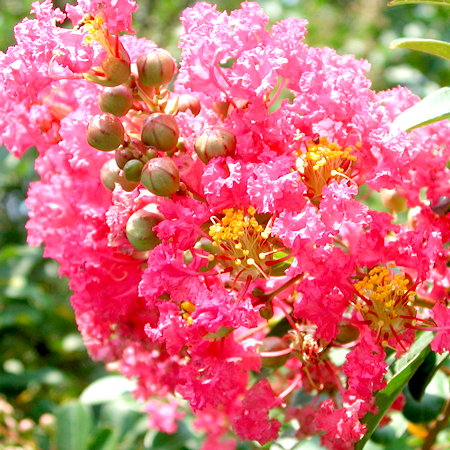

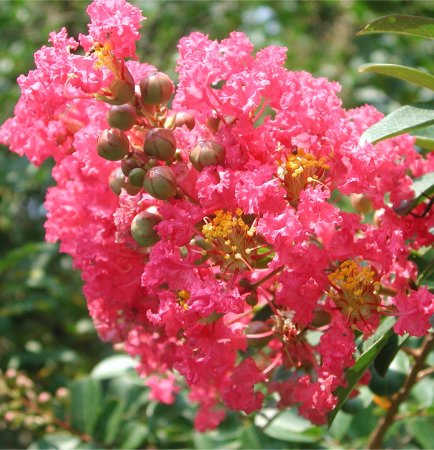
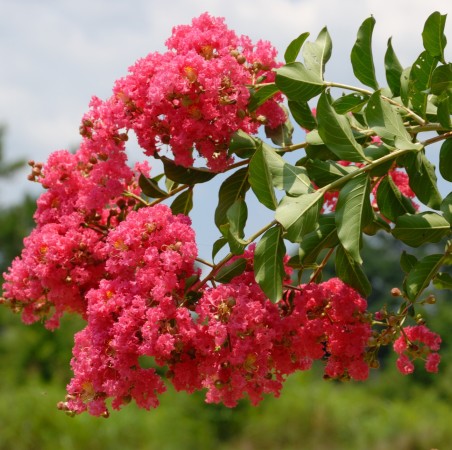
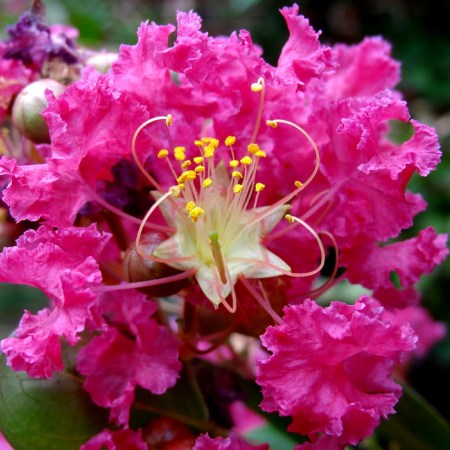
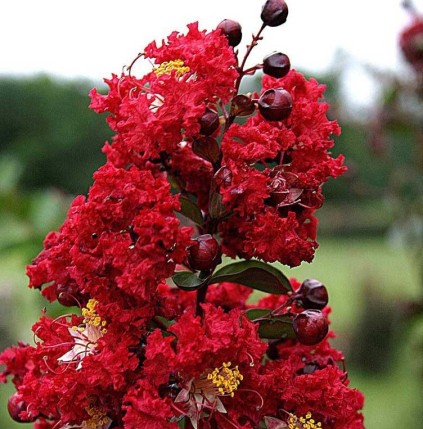
Botanical name Myrtus communis
Family Myrtaceae
Source Leaves
Origin Morocco
Processing Method Steam Distilled
Color/Consistency A thin, reddish brown liquid.
Aromatic Summary / Note / Strength of Aroma A middle note with a medium aroma, Myrtle Essential Oil has a clear, fresh scent that is mildly camphoraceous, similar to that of Eucalyptus.
Blends With Benzoin, Bergamot, Elemi, Eucalyptus, Black Pepper, Cedar Wood, Frankincense, Myrrh, Neroli, Rose, Ho Wood, Hyssop, Jasmine, Lavender, Lemon, Lemongrass, Clary Sage,Coriander, Melissa, Rosewood, and Ylang-Ylang.
Product Abstract
Myrtle is an evergreen shrub with fragrant white or pink flowers. It is native to North Africa but is commonly found in the southern Mediterranean region including France, Spain, Corsica, Tunisia and Italy. Myrtle essential oil is steam distilled from the leaves and twigs and sometimes the flowers. Myrtle's leaves and fruits have been widely used as folk medicine for the treatment of digestive, pulmonary and skin problems in many parts of the world. Its essential oil, which possesses much of the healthful properties of the plant, is also popular among aromatherapy practitioners. Discover what you can gain from having a bottle of myrtle oil stocked in your home by reading the information below.
History
This aromatic evergreen shrub originates from Africa, and grows all around the Mediterranean. It was introduced to Britain in 1597, but generally only flourishes in the south, or under glass (it can also be grown as a pot plant). It has small, shiny, dark green leaves which contain vesicles full of essential oil. The flowers are fragrant and white, five-petalled with a spectacular spray of thin stamens. These are followed by purple-black berries.
Harvesting/Extraction Information
Myrtus communis is obtained by the steam distillation of the myrtle plant’s flowers, leaves, and stem, which is called Myrtus Communis in the botanical world. Its main constituents are Cineol, Myrtenol, Pinene, Myrtenyl Acetate, Geraniol, Linalool, Camphene, and Borneol.
Common Usage
Caution
There is no inherent risk in using myrtle essential oil, but as always, pay attention to your body’s reaction to any new substance or supplement, and consult a doctor if anything unusual occurs.
Key constituents
a-Pinene 18.5–56.7%
1,8-Cineole 18.9–37.5%
Myrtenyl acetate 0.1–21.1%
(þ)-Limonene 5.1–12.7%
Linalool 1.7–9.5%
a-Terpinyl acetate 0–4.4%
a-Terpineol 0–3.3%
Geranyl acetate 1.4–2.9%
Linalyl acetate tr–2.5%
p-Cymene 0.4–1.8%
Estragole 0–1.4%
Isobutyl isobutyrate 0.3–1.1%
Methyleugenol 0.3–0.8%
Safety summary
Hazards Drug interaction; potentially carcinogenic, based on estragole and methyleugenol content.
Cautions (oral) Diabetes medication.
Maximum adult daily oral dose 65 mg
Maximum dermal use level
EU 0.02%
IFRA 0.04%
Tisserand & Young 1.9%
Our safety advice
We recommend a maximum adult daily oral dose of 65 mg for each myrtle oil, based on limits of 0.05 mg/kg/day for estragole, and 0.01 mg/kg/day for methyleugenol. We also recommend a dermal maximum of 1.9% for myrtle oils based on either 1.4% estragole and 0.8% methyleugenol content or 0.2% estragole and 1.0% methyleugenol content, and dermal limits of 0.12% and 0.02% for estragole and methyleugenol, respectively.
Regulatory guidelines
IFRA recommends a maximum dermal use level for estragole of 0.01% in leave-on or wash-off preparations for body and face. IFRA recommends a maximum concentration of 0.0004% methyleugenol in leave-on products such as body lotions. The equivalent SCCNFP maximum is 0.0002%.
Organ-specific effects
Adverse skin reactions Undiluted myrtle oil was moderately irritating to rabbits, but was not irritating to mice; tested at 4% on 25 volunteers it was neither irritating nor sensitizing. Myrtle oil produced no sensitization reactions in 100 subjects when tested at concentrations ranging from 0.28–0.9% in two perfume compositions in a repeat insult patch test. Myrtle oil was non-phototoxic in hairless mice.
Cardiovascular effects Myrtle oil reduced blood glucose by 51% in alloxan-diabetic rabbits four hours after an oral dose of 50 mg/kg, but had no affect serum insulin concentrations.
Systemic effects
Acute toxicity Acute oral LD50 in rats reported as >5 g/kg; acute dermal LD50 in rabbits >5 g/kg. and 3.68 mL/kg . Acute oral LD50 in mice 2.23 mL/kg.
Antioxidant/pro-oxidant activity Two myrtle oils exhibited moderate DPPH scavenging activity with IC50 values of 5.99 and 6.24 mg/mL.
Carcinogenic/anticarcinogenic potential Myrtle oil has demonstrated weak-to-moderate antimutagenic activity. Estragole and methyleugenol are rodent carcinogens; (þ)-limonene has demonstrated anticarcinogenic activity.
Drug interactions Antidiabetic medication, because of cardiovascular effects, above.
Comments In addition to regular myrtle oil, ‘green’ and ‘red’ myrtle oils are available. Green myrtle oil is high in myrtenyl acetate/linalool, and is produced in Corsica, and red myrtle refers to the cineolerich type available from Morocco. At least two subspecies of Myrtus communis exist, with subsp. communis being the most often encountered.